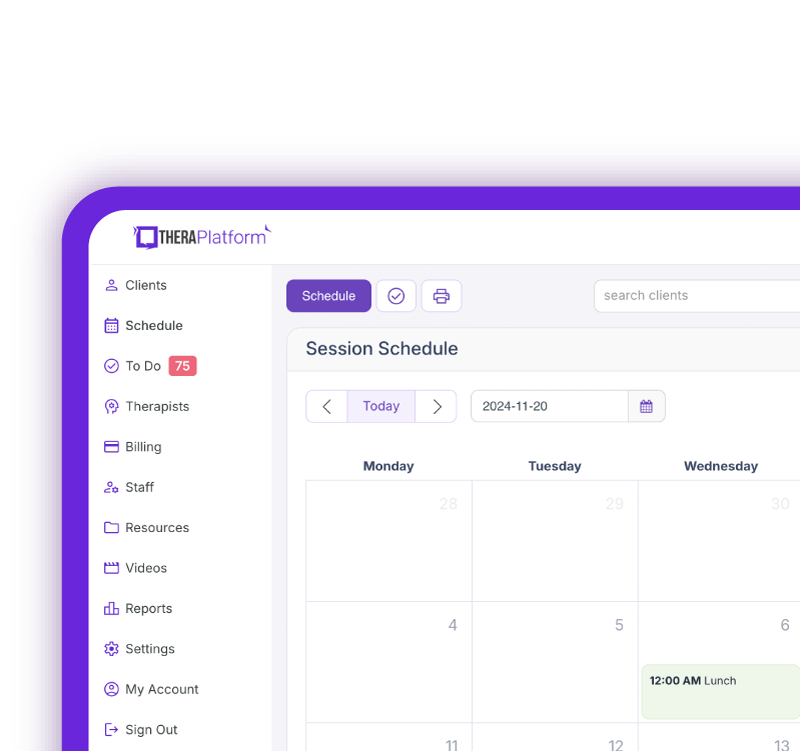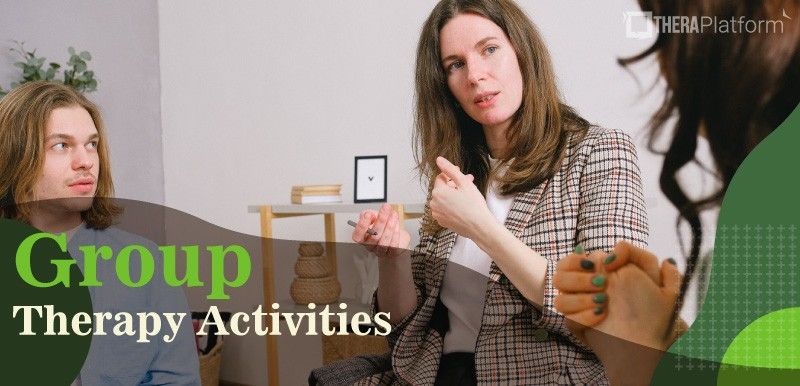10 effective therapy activities for teens and adolescents

Therapy ice breakers and activities are a great way to help people through their sessions, especially adolescents. Adolescence is a critically important phase in a person's life, marked by various challenges and emotional ups and downs. During this period of development, teenagers often grapple with complex issues such as academic pressures, peer relationships, and self-identity. To navigate these challenges successfully, therapy ice breakers can play a pivotal role in fostering positive mental health.
Summary
- Therapy ice breakers help teens feel safe and comfortable in sessions, encouraging self-expression, self-awareness, and emotional processing—especially important during the turbulent adolescent years. Download my free therapy icebreakers and activities list for teens.
- Through role-playing, creative arts, mindfulness, and group games, teens can strengthen communication, self-esteem, and coping strategies, all of which support mental health and resilience.
- Tailoring activities to a teen’s interests—whether creative, experiential, or tech-based—boosts engagement. Digital tools like teletherapy platforms and mental health apps can enhance therapy, especially for tech-savvy clients.
- Success with teens depends on creating a non-judgmental environment and addressing resistance with empathy, patience, and collaborative goal-setting to keep teens invested in the process.
- By leveraging an EHR like TheraPlatform for efficient storage of exercises, therapists can store and manage homework and activities with ease.
Streamline your practice with One EHR
- Scheduling
- Flexible notes
- Template library
- Billing & payments
- Insurance claims
- Client portal
- Telehealth
- E-fax

The role of therapy ice breakers and activities in promoting positive mental health
Therapy ice breakers and activities tailored for teenagers create a safe and non-judgmental space where they can express themselves freely. Therapy ice breakers and activities are designed to encourage introspection and self-discovery, enabling adolescents to process their emotions and thoughts effectively. Engaging in therapy ice breakers and activities allows teens to develop a deeper understanding of their feelings and behavioral patterns, leading to enhanced emotional intelligence and self-awareness.
The benefits of therapy ice breakers and activities for teens
Increased self-awareness
Adolescence is a time of self-exploration, and therapy ice breaker activities facilitate this journey. By encouraging teens to reflect on their emotions and actions, these activities help them recognize their strengths, weaknesses, and areas for personal growth. Through self-awareness, teenagers can make better choices, build healthier relationships, and develop a positive self-image.
Improved communication skills
Effective communication is essential for healthy relationships and emotional well-being. Many teens struggle to express themselves openly and honestly. Therapy ice breakers activities, such as role-playing, group discussions, and creative expression, teach teens how to articulate their thoughts, feelings, and concerns in a constructive manner. These improved communication skills empower them to connect with others on a deeper level, reducing feelings of isolation and enhancing their social interactions.
Increased self-esteem
Adolescence is often plagued by self-doubt and insecurity. Therapy ice breakers activities boost self-esteem by providing teens with opportunities to achieve personal goals, overcome challenges, and receive positive reinforcement. As they witness their own growth and resilience through these activities, their confidence grows, allowing them to approach life's challenges with a more positive mindset.
V6: With the computer - Short EHR
The role of therapy ice breakers and activities in building positive coping skills
Adolescence can be overwhelming, and learning effective coping mechanisms is vital for emotional resilience. Therapy ice breakers and activities introduce teens to coping strategies that help them manage stress, anxiety, and difficult emotions. These activities may include mindfulness exercises, art therapy, journaling, and relaxation techniques. By incorporating these coping skills into their daily lives, teens can better navigate stressors and build a foundation for long-term mental well-being.
Types of therapy ice breakers and activities for teens
Therapy ice breakers and activities for teens encompass a diverse range of approaches that cater to individual needs and preferences. These activities are specifically designed to engage teenagers in a therapeutic setting, fostering personal growth and emotional well-being.
Understanding the various types of therapy icebreakers and activities available can help therapists and caregivers tailor interventions to suit each teen's unique requirements. While some of these therapy ice breakers and activities have, in the past, been considered less beneficial as talk therapy, in reality, the right activities and modalities can help teens and young adults open up more and feel more comfortable in an otherwise awkward situation.
10 ice-breaker activities
- Word Clouds: Help your client build an online word cloud with a list of words that are important to them. There are several sites available for this, but Wordclouds.com is relatively straight forward. Essentially, you ask the client to type in a certain number of words that feel important to them (e.g., pets, work, baseball). The program allows you to choose how much weight each word should hold, which could be an interesting conversation starter.
- Life Timelines: Pull up a virtual whiteboard, draw a line, and ask the client to add a certain number of important events in their life. You may also want to make your own timeline to share. Let the conversation flow from there!
- Pictionary: This can be played on any virtual whiteboard! You may want to ask the client to draw something that has a story behind it or is important to them.
- Wheel of Names: For a group session, find a list of icebreaker questions that are relevant to your client’s age (can easily be found through a search engine). Then, enter all the participants' names into the wheel on wheelofnames.com. The wheel will spin and land on a name. Whoever it lands on gets to answer an icebreaker question from your list! To help make your clients more comfortable, you may want to give them an option of two or three questions to choose from. To provide a visual, you could type the questions up on a powerpoint for your clients to read.
- Show and Tell: This works especially well for clients who are in their homes. Tell them they have 1 minute to grab something from their house that is important to them, then ask them to come back and tell you all about it. You may also want to take a turn showing and telling! This doesn’t have to be limited to pediatrics. You can easily sell this activity to adults as well.
- Name, Place, Animal, Thing: This popular game works well via telehealth, especially in groups. To play, someone picks a letter. Each player has to list a famous person's name, a place, an animal, and a thing that begins with that letter. The first person to type all of the answers into the online chat box wins!
- 20 Questions: This classic game helps you and your client think of something (e.g., place, object, animal) and you ask questions to try to guess what you’re thinking of. This is a low pressure option that doesn't require the client to say much about themselves, but allows them to start therapy with something fun and laid-back.
- About Me: Find an “About Me” themed worksheet from a site like TeachersPayTeachers.com and screen share it (or upload it to your resources if you’re using TheraPlatform). Don’t forget to fill one out about yourself before asking your client to do it; remembering that if they learn more about you, they feel more trusting and comfortable, which will likely increase buy-in to therapy techniques.
- Storymaker: Go to ABCya.com and search “Storymaker” to find a fun little activity for children to create short stories with words, pictures, and drawings. Use this opportunity to ask your client to write a story about their life, their favorite vacation or birthday, or to just describe all their favorite things!
- Would You Rather?: Psychcatgames.com has an online version of “Would You Rather”. You could screen share this site for an easy game that can be played for any amount of time. The questions are geared towards older adolescents or adult clients.
In addition to therapy icebreakers, other types of activities may be beneficial to adolescents as well. Before getting started, it's a good idea to understand the required steps to optimize these activities and your session time.
Free Resources for Therapists
Click below and help yourself to peer-created resources:

Strategies for selecting the appropriate therapy activities for teens
Therapists should consider teens' individual needs, interests, and comfort levels when selecting therapy ice breakers activities. Collaboration with the teenagers in the decision-making process ensures that the chosen activities resonate with them and enhances their engagement in the therapeutic journey.
Tips for setting goals and objectives for therapy activities
As with any other therapy process, clear and achievable goals are essential for tracking progress and providing direction in therapy. Setting specific objectives for each activity helps teens understand the purpose behind them and fosters a sense of purpose in their therapeutic experience.
Guidelines for ensuring a safe and supportive therapy environment
A supportive and non-judgmental environment is crucial for the success of therapy activities. Therapists and facilitators should create a space where teens feel comfortable sharing their thoughts and emotions without fear of criticism. Teens are developmentally likely to be more sensitive to perceived rejection or criticism, so creating a safe space is probably the most important part of therapy with teens.
Strategies for addressing resistance or reluctance to therapy activities
Some teens may initially resist participating in therapy activities due to discomfort or skepticism. Patience, empathy, and open communication are key in understanding their concerns and gently guiding them towards the benefits of the activities.
Examples of therapy activities for teens
Creative activities
- Art therapy: Art therapy encourages self-expression and emotional release through artistic mediums such as painting, drawing, and sculpting. By creating visual representations of their thoughts and emotions, teens can gain insights into their inner world and find solace in the creative process.
- Collage-making: Collage-making involves assembling images and materials to create a visual representation of thoughts and emotions. It enables teens to communicate complex feelings in a unique and artistic way.
- Music therapy: Music has a profound impact on emotions and can be an effective tool in therapy. Music therapy involves listening to, composing, or playing music to explore feelings and improve communication. It can be particularly beneficial for teens who find it challenging to express themselves verbally.
- Drama therapy: Drama therapy involves role-playing and improvisation to explore and understand various emotions and experiences. Through enacting different scenarios, teens can gain perspective on their own challenges and develop empathy towards others.
Experiential activities
- Role-playing: Role-playing scenarios related to real-life challenges allows teens to practice communication, conflict resolution, and problem-solving skills in a safe environment.
- Obstacle courses: Engaging in obstacle courses or team-building activities fosters resilience and self-confidence. Overcoming physical challenges can translate into overcoming emotional obstacles.
- Outdoor therapy: Nature can have a therapeutic effect on mental health. Outdoor therapy involves conducting therapeutic activities in natural settings, such as hikes, camping trips, or nature walks. The serene environment promotes relaxation and helps teens connect with their emotions on a deeper level.
- Adventure therapy: Adventure therapy utilizes physically and mentally challenging activities, such as rock climbing or ropes courses, to promote personal growth and build resilience. Conquering these challenges fosters a sense of accomplishment and empowerment.
- Animal-assisted therapy: Interacting with animals, such as therapy dogs or horses, can have a calming and comforting effect on teens. Animal-assisted therapy facilitates emotional regulation and communication skills, as teens form bonds with these non-judgmental companions.
Mindfulness-based activities
- Deep breathing exercises: Teach teens deep breathing techniques to reduce stress and anxiety. Simple exercises can be practiced anywhere and help in grounding emotions.
- Guided meditation: Guided meditation sessions lead teens through relaxation and visualization exercises. It helps them develop mindfulness, focus, and emotional regulation.
- Meditation: Mindfulness meditation helps teens focus on the present moment, promoting emotional stability and stress reduction. By cultivating mindfulness, teens learn to manage their thoughts and emotions more effectively.
- Relaxation techniques: Relaxation exercises, such as deep breathing and progressive muscle relaxation, aid in reducing anxiety and tension. Incorporating these techniques into therapy activities equips teens with valuable coping skills they can employ during challenging situations.
Incorporating technology into therapy activities for teens
In today's digital age, technology can play a significant role in enhancing therapy activities for teens. By leveraging technology, therapists can create innovative and engaging experiences that resonate with tech-savvy teenagers.
Teletherapy: Supporting therapy activities for teens
Teletherapy, or online therapy, provides a convenient and accessible platform for teens to engage in therapy from the comfort of their homes. Video conferencing allows therapists to conduct individual or group sessions effectively, breaking down geographical barriers and improving accessibility to mental health support.
Digital tools: Apps and virtual reality in therapy activities
- Apps: Various mental health apps offer tools and resources that can complement therapy activities. Apps for meditation, mood tracking, and coping strategies can help reinforce therapeutic concepts and provide ongoing support between therapy sessions.
- Virtual reality (VR): VR technology can create immersive therapeutic experiences for teens. For example, virtual environments can be used to simulate stress-inducing situations, allowing teens to practice coping skills in a controlled setting.
Therapy activities provide teenagers with a safe space to explore their emotions, build resilience, and develop essential life skills. By incorporating a diverse range of activities, therapists can cater to the unique needs and preferences of each teen, fostering a positive and supportive therapeutic experience.
With that, a clinician may discover that a teen excels in a particular therapy and may recommend one the following. Some of these activities may require the provider to have specialized training.
For those interested in delving deeper into therapy activities for teens, there are numerous books, research papers, and online resources available. Exploring these materials can enrich one's understanding and application of therapy techniques to support and empower adolescents on their journey to positive mental health.
Streamline your practice with One EHR
- Scheduling
- Flexible notes
- Template library
- Billing & payments
- Insurance claims
- Client portal
- Telehealth
- E-fax

Resources
Theraplatform is an all-in-one EHR, practice management and teletherapy solution that allows you to focus more on patient care. With a 30-day free trial, you have the opportunity to experience Theraplatform for yourself with no credit card required. Cancel anytime. They also support different industries including mental and behavioral health therapists in group practices and solo practices.
More resources
- Therapy resources and worksheets
- Therapy private practice courses
- Ultimate teletherapy ebook
- The Ultimate Insurance Billing Guide for Therapists
- The Ultimate Guide to Starting a Private Therapy Practice
Free video classes
- Free mini video lessons to enhance your private practice
- 9 Admin tasks to automate in your private practice
References and specific resources
- Child Mind Institute: Provides insights into child and adolescent mental health, including therapy techniques and activities.
- The Art Therapy Credentials Board (ATCB): Offers information about art therapy and its benefits for adolescents.
- Association for Play Therapy (APT): Focuses on play therapy and its applications for teenagers.
- Adventure Therapy International: A resource for information about adventure therapy and its benefits for teens.
- Mindful: Offers mindfulness-based resources and guided meditations for teenagers.
FAQs about therapy icebreakers and activities for teens
Why are therapy ice breakers important for teens?
Therapy ice breakers help teens feel more comfortable and build trust early in the therapeutic relationship, making it easier for them to express emotions, engage in activities, and participate meaningfully in the session.
What types of therapy ice breaker activities work best with adolescents?
Effective options include creative activities like art or journaling, experiential tools like role-playing or group games, and mindfulness practices such as guided breathing or meditation—tailored to a teen’s interests and comfort level.
How can therapists handle teens who resist participating in activities?
Using empathy, collaboration, and choice-based engagement can reduce resistance. Allowing teens to help select activities and explaining their purpose increases buy-in and supports a non-judgmental, safe environment.



